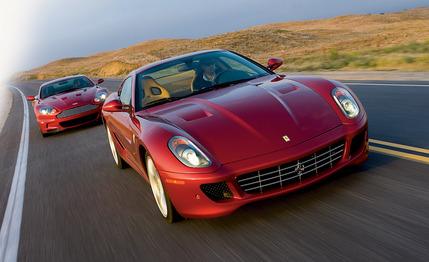 Comparison Tests
Comparison Tests
Should you get on Jeopardy! here’s the likely question to the answer, “A very popular video game about racing”: What is Gran Turismo? Well, that’s one answer.
Gran turismo (or grand touring) is a term cooked up by car-crazy Italians ages ago to describe an automobile that could do it all. A GT combined the handling and high performance of a sports car with the ability to transport two grown-ups and their luggage in comfort across great distances. In the process, GTs also became synonymous with power and beauty, all the way back to the Alfa Romeo 8C-2900B coupes of the 1930s. Generally, GTs are front-engine because that way they have a usable trunk and good visibility. GTs are special, too, often the most glamorous cars their makers produce and among the most expensive.
Which brings us to the two cars you see here, the Ferrari 599GTB Fiorano and the Aston Martin DBS, both of which embody the modern meaning of GT.
The Aston Martin is the newer of these two vehicles. It was introduced at the Pebble Beach Concours d’Élégance in August 2007 but didn’t go on sale in the U.S. until earlier this summer. The name pays homage to the crisply styled coupe from 1967, and it is, essentially, a more muscular, faster, and more expensive version of the DB9 that has been on sale since 2005.
Underpinning the DBS’s sleek lines is Aston’s so-called VH aluminum architecture that also provides the bare bones for the DB9 and the V-8 Vantage. A new cross-dashboard supporting beam, a front strut crossbrace, and solid mounting of the rear subframe are among the modifications to the structure. To reduce weight, the trunk enclosure and lid, the door-opening surrounds, the hood, and the front fenders are made from carbon fiber.
Compared with the DB9, the DBS’s track is 0.7 inch wider at the front and 0.8 inch at the rear, and the car sits 0.4 inch higher. Thanks to the use of the carbon-fiber panels and carbon-ceramic brakes, the DBS, at 3820 pounds, is 220 pounds lighter than the last DB9 we tested.
It’s somewhat more powerful, with 510 horsepower (versus 470 in the DB9). Aston has found 40 additional ponies from its 5.9-liter V-12 by fitting revised cylinder heads and a new intake manifold. Torque of 420 pound-feet is down by 23, peaking slightly higher, at 5750 rpm, although no fewer than 369 lb-ft are on hand from 2000 rpm. The power is transmitted via a rear-mounted six-speed Graziano manual transaxle, one of the options on the DB9.
The DBS has a control-arm suspension all around, but an adaptive damping system is unique to this car. It uses two separate valves that allow the shocks to have five different damping levels, determined by an electronic control unit reacting to throttle and brake-pedal position, steering-wheel angle, and vehicle speed. A special track mode locks the shocks in their firmest setting. The stability control also has been upgraded, with a competitive driving mode that allows some sideways action before the electronics intervene. The system also can be switched off completely. The carbon-ceramic brakes are a first for Aston Martin and are 15.7 inches in diameter up front, 14.2 inches out back (the same as the Ferrari’s).
The changes are costly, with the base price rising from $168,950 for a DB9 to a whopping $266,350 for a DBS. With Infa Red paint (specific to our test car) and an alarm upgrade, our tester stickered at $270,430.
The Ferrari 599GTB went on sale in the U.S. last spring as a replacement for the 550/575 series that had been in production since 1996. Ferrari has since sold about 500 599s. The base price is $318,045, although we suspect that most of them sticker for a lot more on the evidence of this optioned-out $385,419 tester. Items such as the $26,000 paint job, the $1776 Ferrari fender badges, and $12,547 of interior carbon-fiber trim must make the beancounters happy.
Like the DBS, the 599 has aluminum underpinnings and body panels and also features a hi-po, large-capacity V-12. In this case, the detuned Enzo unit displaces 6.0 liters, makes a solid 612 horsepower, and drives through Ferrari’s F1 SuperFast automated manual transmission.
Ferrari also resorts to electronics to balance the tricky equation between sports-car handling and the kind of ride comfort that will allow owners to use their cars as grand tourers. In this case, the 599 uses electromagnetic shocks, their calibration partly controlled by the manettino, a five-position rotary switch on the steering wheel that also governs shift speed and traction- and stability-control settings.
Over roads as diverse as L.A.’s clogged freeways to the nearly empty two-lanes that spear through the Anza-Borrego Desert, we wrung out both of these gorgeous machines. Here’s what we discovered.